|
|
JAMES BOND FACT FILES |
|
|
JAMES BOND FACT FILES |
|
|||
 |
|||
|
Following the publication of their second omnibus More Gild-Edged Bonds in August 1965, the Macmillan Company then re-issued new hardcover editions of the first seven Ian Fleming James Bond novels for which they held the rights. Published on January 17, 1966 using the Book Club sheets, the seven titles had striking new dust jackets by Jerome Kuhl (1927-2016). |
|||
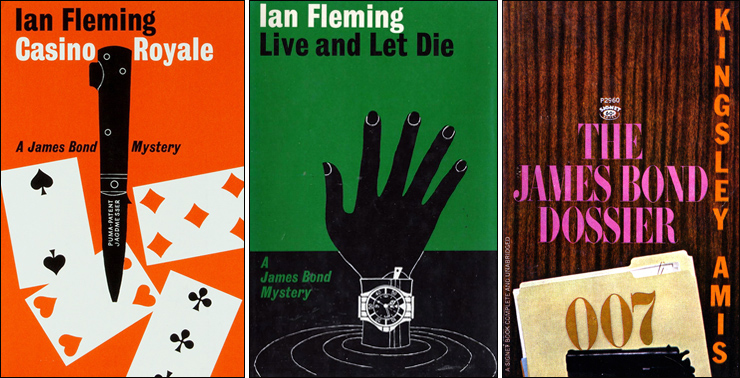 |
|||
|
These full-price hard covers were published in fewer numbers, and were easily outsold by the Book Club editions available concurrently with uniform cover art. With the subtitle ‘A James Bond Mystery’, Jerome Kuhl's stylized two-colour dust jackets make the Macmillan editions highly collectible in their own right. In July 1966, just after the release of the last of Ian Fleming stories in hardback, the Signet paperback edition of the James Bond Dossier by Kingsley Amis was published, with a cover very similar in style to 007 James Bond: A Report by O.F. Snelling which debuted in paperback a year earlier. |
|||
|
|||
|
OCTOPUSSY was published by the New American Library in June 1966 under its shortened title, with a dust jacket once again designed by Paul Bacon. The clever graphic motif of a sniper's rifle whose barrel merges into an octopus tentacle therefore represented both stories in one image. The design was replicated on the cloth boards of the hardback this time stamped in red. The rear of the dust jacket featured the Horst Tappe portrait of the author and was once more uncredited. The text of the two short stories did employ the American spellings of some English words, as was the custom with most US printings of Ian Fleming's novels. |
|||
 |
|||
|
The US New American Library hardcover edition of OCTOPUSSY is also unique in that it includes twelve illustrations by Paul Bacon [pictured above], not present in the UK Jonathan Cape edition. |
|||
|
|||
|
|||
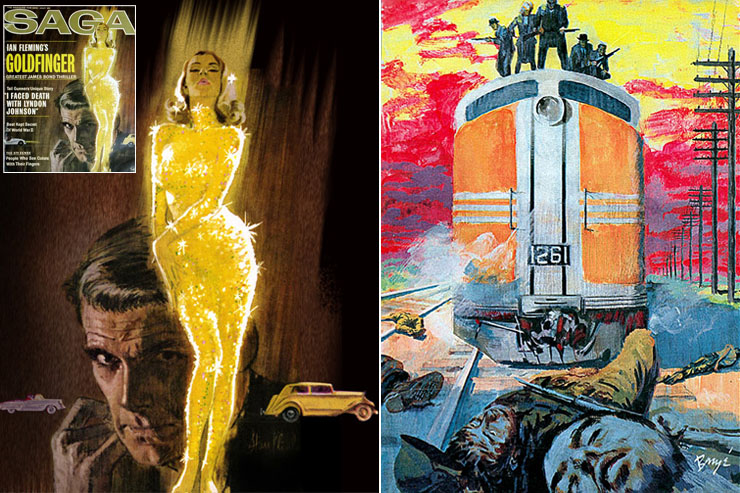 |
|||
|
On October 7, 1966 LIFE Magazine printed the first part of a two-part adaptation of John Pearson's The Life of Ian Fleming, to coincide with the publication of the US hardcover by McGraw-Hill. The special fold-out cover featured Ian Fleming in a supercharged Bentley photographed by Loomis Dean (1917-2005). The Bentley was the same 4.6 litre model driven by James Bond in the 1955 novel MOONRAKER. The photograph was part of a series taken of Ian Fleming in 1962 for an interview with the author published in the August 10th issue of LIFE Magazine. The second part of The Life of Ian Fleming adaptation appeared in LIFE Magazine on October 14, 1966. The US hardcover edition of The Life of Ian Fleming retained the same Jan Pienkowski (1936-2022) designed dust jacket artwork seen on the UK edition published by Jonathan Cape. |
|||
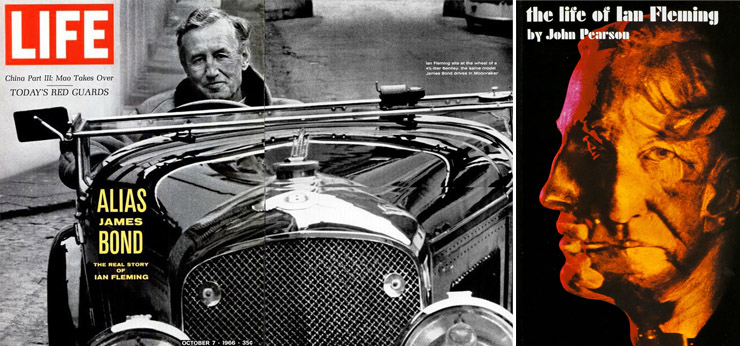 |
|||
|
1966 saw the release of Signet's third paperback box-set collection, this time with 13 books and erroneously titled The Complete James Bond. Now priced at $7.80, this would be the last set issued by Signet before they had actually released the final paperback of the series. OCTOPUSSY would never appear as part of a Signet box set, and did not make its US debut in paperback until July 1967, at the same time it was released in the UK by PAN Books. Both paperbacks now included Ian Fleming's 1963 short story THE PROPERTY OF A LADY, originally commissioned by auction house Sotheby's, and included in their 1962/63 yearbook The Ivory Hammer: The Year at Sotheby's, 219th Season 1962-1963, which was published in hardback on both sides of the Atlantic. The short story then later appeared in the January 1964 10th anniversary issue of PLAYBOY magazine accompanied by a double-page illustration by Richard Frooman. Ian Fleming was reportedly unhappy with the story and refused payment from Sotheby's. The paperback publication of OCTOPUSSY therefore marked the last time an original Ian Fleming James Bond story was published in the USA. 007 IN NEW YORK was not published in the UK until 1999, although it still appeared in the US editions of Thrilling Cities. The short story is now included in all editions of OCTOPUSSY. The US Signet paperback edition of OCTOPUSSY utilised a black & white photograph of Ian Fleming by Dan Wynn on the cover, and retained the Paul Bacon illustrations which are missing from UK editions of the book. Reviews were once again mixed, with Clarence Petersen of the Chicago Tribune perhaps summing things up most succinctly in his July 11, 1967 review The end of Bond:
|
|||
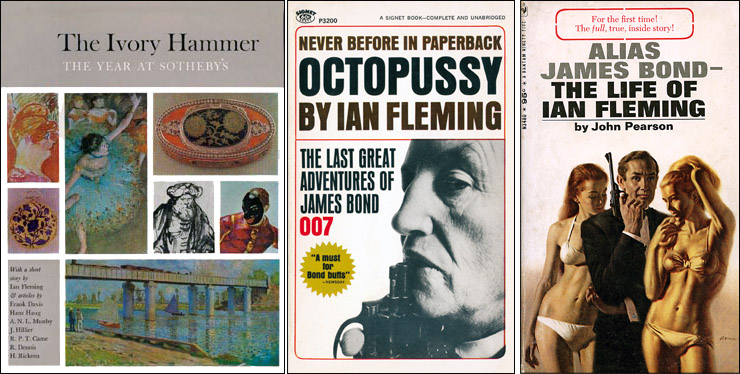 |
|||
|
John Pearson's biography was slightly re-titled for its May 1967 paperback release from Bantam Books and became Alias James Bond - The Life of Ian Fleming. The Bantam paperback cover featured a painting by James Bama who presented Ian Fleming in a Sean Connery style James Bond pose flanked by two bikinied girls; one of which presumably represented Honey Rider from DOCTOR NO, and the gold painted one Jill Masterton from GOLDFINGER. Bama would later paint the cover for the first US paperback release of COLONEL SUN in 1969, followed by four stylish paintings for Bantam's re-issue of early Ian Fleming James Bond novels in the 1970s. The first James Bond continuation novel had been announced in April 1967, just before the publication of OCTOPUSSY, when Kingsley Amis said he had been engaged by Glidrose Productions (the company that held the literary copyright to James Bond and the Ian Fleming novels) to continue where the late Ian Fleming left off. The resulting novel was published in London by Jonathan Cape on March 28, 1968 and in New York by Harper & Row on May 1st. Both hard cover editions had a wraparound dust jacket featuring a surrealist painting by Tom Adams (1926-2019). |
|||
|
|||
|
Although it was no secret COLONEL SUN was written by Kingsley Amis, Glidrose chose to credit the author as Robert Markham on the UK cover, with the idea that any future James Bond novels could be written using the same pseudonym. An abridged version of COLONEL SUN appeared in the April 1968 issue of TRUE The Man's Magazine, accompanied by a stylish cover and four full colour illustrations by Robert ‘Bob’ K. Abbett (1926-2015). The US hard cover edition was then published by Harper & Row on May 1, 1968 and added Kingsley Amis’ name in brackets on the dust jacket. COLONEL SUN proved a best-seller and garnered much better reviews than did the latter Ian Fleming novels. The idea of using the Robert Markham pseudonym was not repeated, and the later John Gardner and Raymond Benson continuation novels were published under their own name. It was not until 2008 when DEVIL MAY CARE was released, that the curious credit ‘Sebastian Faulks writing as Ian Fleming’ was used. All subsequent James Bond novels have also carried just the authors' name. Ian Fleming's widow did not like Kingsley Amis, and was not happy about the writing of COLONEL SUN and expressed her displeasure at the time, although she had no copyright control over her husband's works. The Daily Telegraph printed a scathing review of COLONEL SUN by Anne Fleming when the book was published. Six months before his death Ian Fleming had sold 51% of his Glidrose shares to Booker Brothers for £100,000 ($280,000 in 1964), which gave them the controlling interest in the literary works. Ironically Ian Fleming's older brother Peter (1907-1971) was on the board of Booker Brothers at the time COLONEL SUN was commissioned. It was not until after Anne Fleming's death in 1981, that Glidrose chose to continue the James Bond series again in print with LICENCE RENEWED by John Gardner. |
|||
|
The US paperback edition of COLONEL SUN was published by Bantam Books in May 1969 sporting a film poster-style cover by American artist James Bama (1926-2022). Given the style of the artwork, James Bond poster artists Frank C. McCarthy and Robert McGinnis have both been erroneously credited with the cover painting, but it was James Bama who had provided many covers for the publisher, who were for many years one of the largest producers of paperbacks in the USA. Bantam most famously held the paperback rights from 1967-1978 for the successful series of novelizations based on episodes of the US TV-series Star Trek. James Bama was also providing covers for Bantam's popular Doc Savage series during the time COLONEL SUN was published in paperback, and later when the company issued CASINO ROYALE, FROM RUSSIA WITH LOVE, DOCTOR NO and GOLDFINGER in the early 1970s. James Bama often used himself or American model/actor Steve Holland (1925-1997) as a photo-reference for his paintings, and it is undoubtedly Holland who served as the reference image for Bantam's 1972 GOLDFINGER cover at least. The only new James Bond related fiction in the 1970s was the publication of John Pearson's James Bond: The Authorized Biography of 007, which first appeared as a hardback in the UK in October 1973 from Sidgwick & Jackson, and later in the USA in January 1974 from William Morrow & Co. Although not commissioned by Glidrose, the book was sanctioned by the James Bond copyright holders as John Pearson knew then chairman Peter Janson-Smith, who gave permission for the work to be published. The book was a fictional account of the life of Secret Agent 007, written from Pearson's point-of-view as he interviews the ‘real’ James Bond (now aged 53) in Bermuda. John Pearson (born 1930) had worked with Ian Fleming, and like Kingsley Amis before him, now followed up his factual analysis of the author with a work of fiction. Not generally considered as a James Bond continuation novel, James Bond: The Authorized Biography of 007 was well-received upon publication, and a paperback edition followed in March 1975 from Pyramid Books. John Pearson's spoof biography was reprinted many times in subsequent years. COLONEL SUN on the other hand was out-of-print for at least fifteen years until its 1993 paperback printing in the UK by Coronet Books which was at the suggestion of 007 MAGAZINE Editor & Publisher Graham Rye. |
|||
|
|
|||
|
The James Bond novels by Ian Fleming were kept in print in the USA throughout the 1970s by Signet, who also produced movie tie-in paperbacks of ON HER MAJESTY'S SECRET SERVICE and THE MAN WITH THE GOLDEN GUN as they still held the rights to those novels at the time. Bantam Books published Ian Fleming's earlier novels in an arrangement with Macmillan; including their own movie tie-in editions of DIAMONDS ARE FOREVER and LIVE AND LET DIE both of which retained the poster artwork of Robert McGinnis. Unusually there was also a Book Club hardcover edition of DIAMONDS ARE FOREVER (with the Robert McGinnis poster artwork on the cover), although there had never been a uniform Book Club edition issued in the mid-1960s to match the rest of the series then in circulation. |
|||
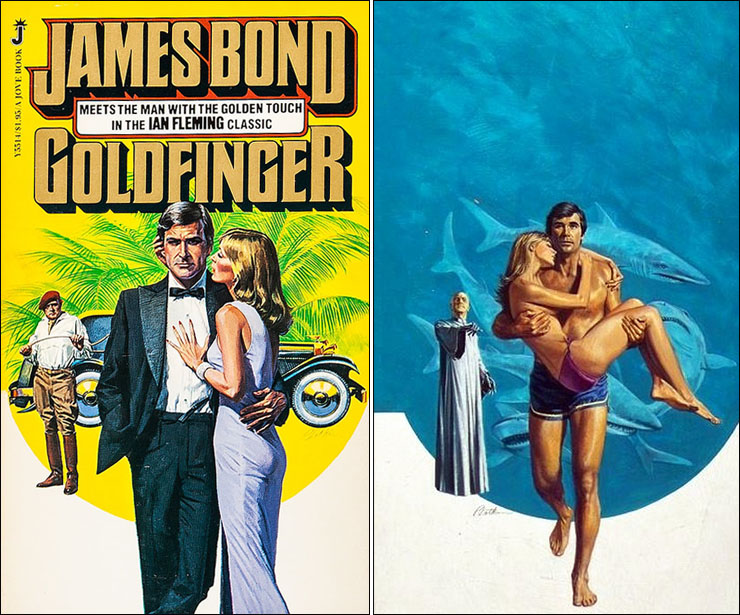 |
|||
|
Early 1980 saw the first six Ian Fleming novels starting with GOLDFINGER published by Jove Books (under another arrangement with Macmillan) with startling new covers by Barnett Plotkin (1932-2003). James Bond was literally brought up-to-date, and Ian Fleming's hero would now not look out of place in an episode of TV's Dallas. FOR YOUR EYES ONLY appeared in June 1981 and was effectively the movie tie-in edition for Roger Moore's fourth 007 outing, this was followed by MOONRAKER a month later in the same style. Although Glidrose Productions (later Ian Fleming Publications), the company who controlled the literary rights Ian Fleming's works did not allow the face of James Bond to be depicted on book covers in the UK (with the exception of film tie-in paperbacks), they were less strict in the USA. However, the 1980/81 US Jove series of paperbacks would be the last where James's Bond face was seen until a small image appeared on the cover of OCTOPUSSY AND THE LIVING DAYLIGHTS from Penguin Books in 2002, as part of the ‘Bond Re-Jacketed’ series illustrated by Richie Fahey and Roseanne Serra. The announcement that a new author was to reboot the James Bond novels in 1981 effectively brought to a close the first chapter in the American publishing history of Ian Fleming's remarkable creation. A new series of James Bond novels was launched starting with LICENCE RENEWED by John Gardner, with Raymond Benson continuing the series from 1997. A new story then appeared almost annually until 2002. Ian Fleming's James Bond novels were re-issued alongside the new John Gardner titles published in paperback by Berkley Books in the early 1980s, and an attempt was made to unify the original and new series with the use of a simple silhouette on the cover. The character of James Bond had ultimately now become how Ian Fleming described him in the final chapter of MOONRAKER as he says goodbye to Gala Brand:
|
|||
|
|
|||
 |
|||